Sinclair C5 'still brings joy' 40 years on, says inventor's son
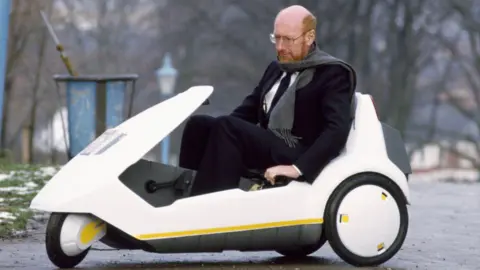 David Levenson
David LevensonForty years after British entrepreneur Sir Clive Sinclair invented the Sinclair C5 his son said it was "brilliant to see people are still enjoying them".
The tricycle-like vehicle, which has a pedal-assisted electric motor, was invented by Sir Clive in 1985.
A group of enthusiasts rode their C5s in a rally from Histon to Cambridge on Sunday, finishing at the Sinclair Building on Willis Road, which was the former headquarters of the business.
Bryan Griffin, 57, from Northampton, who arranged the rally with fellow C5 fans, said: "People love them, and the younger generation asks if they can hire them - they don't realise they're 40 years old."
The enduring appeal of the C5 is perhaps best summed up by Sir Clive's son, Crispin Sinclair, 59.
"It was probably a bit early for its time, but a beautiful design," he said.
"When you look at them, they haven't dated."
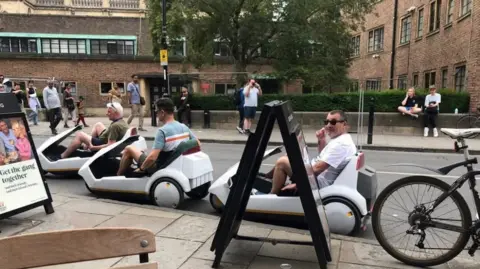 Bryan Griffin
Bryan GriffinModern-day C5 enthusiasts regularly meet up, and Sunday's rally to Cambridge, which was first posted on Facebook group Odd Things Around Cambridge, attracted 10 C5 owners who travelled from Hertfordshire, Bedfordshire, Lincolnshire, Suffolk and Oxfordshire.
"We all have a mutual love for the C5," organiser Mr Griffin said.
"We try not to do journeys that are too long, but this was about 12 miles there and back - so we all made it.
"With newer, lighter batteries they have a much better range than they did."
The C5's size means it was fairly easy to transport for meetings such as this.
"One chap can get his [C5] into his Nissan Micra," he said.
Mr Griffin bought his C5 in 2022 and paid £850 for it.
"It needed a few bits and pieces but it was useable," he said.
He takes it "to the pub and to Tesco as it's very easy to park".
"People who see it love to come over and talk and the younger generation often asks where they can hire them - they don't realise these things are 40 years old because they're used to e-bikes and scooters.
"But people just seem to love the C5," he added.
What is the Sinclair C5?
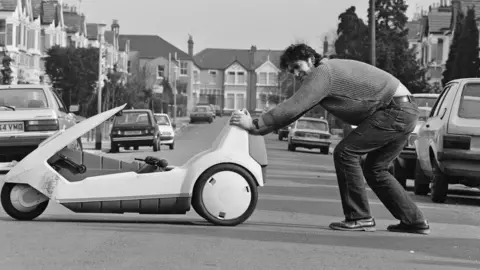 Harry Prosser/Daily Mirror/Mirrorpix/Getty Images
Harry Prosser/Daily Mirror/Mirrorpix/Getty Images- The C5 was launched on 10 January 1985 at Alexandra Palace in London and was designed to revolutionise road transport
- The electric tricycle was built in Merthyr Tydfil in Wales and was available by mail order, priced at £399
- Its battery provided a range of 18.7 miles (30km) and could reach a top speed of about 15mph (24k/ph)
- It failed to sell in large numbers - out of 14,000 made, 5,000 were sold before production was wound up
- Buyers were reportedly disappointed with its limited range, slow speed and inability to climb hills
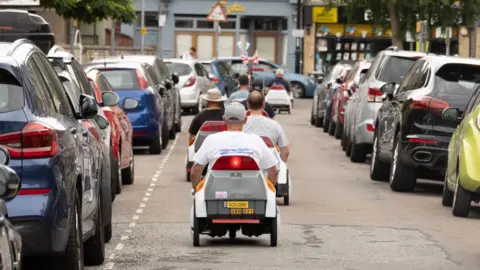 ARU
ARUC5 owner Neil Cubitt brought his model from Brandon, Suffolk, for the rally.
He bought his first broken one in 2009 and has been restoring them ever since.
"I taught myself how to repair it and I've done about 100 since then.
"When I first got my C5 my wife thought I was mad," Mr Cubitt admitted.
But with the rise in electric vehicles, interest in C5s was also rising.
"You can buy a basket case from £600 and and a fully restored one at about £2,000.
"I think Clive Sinclair - in his day - was a very great entrepreneur, way ahead of his time. He was more ahead than the technology."
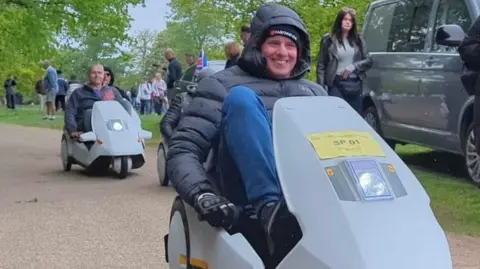 Bryan Griffin
Bryan Griffin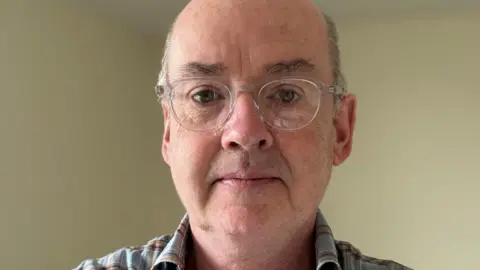 Crispin Sinclair
Crispin SinclairCrispin Sinclair recalled having one of his father's C5s at sixth form college and taking it into Cambridge.
"I got chased by a bunch of yobbo's but fortunately my friends were there and the others ran off."
"I think the idea of a little electric vehicle was absolutely spot on and very early - but probably a different format would have been more successful - perhaps a little electric bike or maybe a little car.
That said, he admitted the C5 was a "lovey thing to zip along in and there's a look about them as well - I think the designer did a great job on the aesthetics of the vehicle".
"Even though it's 40 years old it still looks modern."
Asked if his father was disappointed the C5 did not take off, he said: "I don't think so - if it doesn't work, it doesn't work and he'd move on to the next project.
"As he used to say, 'never look back'."
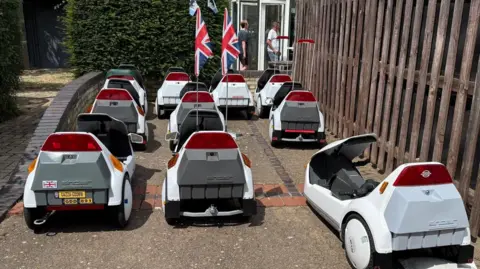 Simon Middleton
Simon MiddletonFollow Cambridgeshire news on BBC Sounds, Facebook, Instagram and X.
